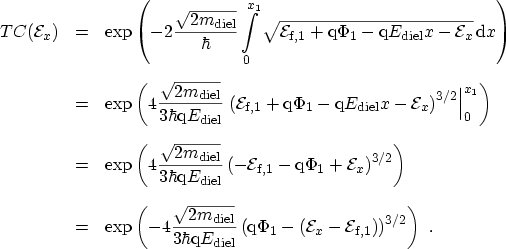The original FOWLER-NORDHEIM formula assumes a triangular shape of the energy
barrier. This is motivated by the fact that only tunneling at strong electric
fields was studied. The WKB-approximation (3.55)
for the transmission coefficient reads
The classical turning point  is (see the left part of
Fig. A.1)
is (see the left part of
Fig. A.1)
and the dielectric conduction band edge for a triangular barrier
where the electric field in the dielectric
 is caused by the different
Fermi levels and the work function difference
is caused by the different
Fermi levels and the work function difference
 :
:
The third approximation is to assume equal materials for both electrodes,
so that
 . The WKB-based transmission coefficient can then
be applied and yields
. The WKB-based transmission coefficient can then
be applied and yields
 |
(A.6) |
Using this expression in (A.5) the current density becomes
 |
(A.7) |
This integral cannot be solved analytically. Hence, the fourth
approximation is to expand the square root into a first order
TAYLORA.1series around  :
:
 |
(A.8) |
Inserting this expression into (A.7) and setting
 yields
yields
 |
(A.9) |
With
 |
(A.10) |
and
 |
(A.11) |
the current density becomes
 |
(A.12) |
The fifth assumption is now that
 , leading to
, leading to
 |
(A.13) |
or
 |
(A.14) |
which is the equation commonly known as the FOWLER-NORDHEIM formula. Note that
there is a difference between the effective electron mass in the electrode
(
 ) and the effective electron mass in the dielectric (
) and the effective electron mass in the dielectric (
 ).
).
A. Gehring: Simulation of Tunneling in Semiconductor Devices

![]() . The WKB-based transmission coefficient can then
be applied and yields
. The WKB-based transmission coefficient can then
be applied and yields



